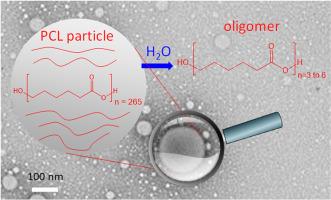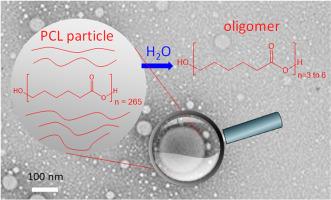定量hplc -质谱分析表明,水溶液和生化介质的组成对亚微米聚己内酯可溶性水解产物的释放有很大影响
IF 4.5
2区 化学
Q2 POLYMER SCIENCE
引用次数: 0
摘要
微塑料和纳米塑料在环境中的积累是一个主要问题,可生物降解聚合物作为一种更稳定的材料的替代品正受到越来越多的关注。生物可降解塑料的降解产物尚未确定。在目前的工作中,我们研究了聚己内酯(PCL),一种用于越来越多的包装和医疗应用的聚合物。我们收集了亚微米PCL颗粒(直径100 - 1000 μm)降解过程中可溶性低聚物释放的定量数据。这是通过合成表征良好的PCL低聚物而实现的,然后将其用于hplc -质谱分析方法的开发。该分析首先应用于在水介质中进行的与环境降解有关的降解研究。我们观察了温度和盐度的影响,并在亚微米尺度上获得了PCL水解产物释放机理的具体信息。同样的方法随后被应用于毒性研究中使用的细胞培养基中PCL的降解,在细胞存在和不存在的情况下,PCL颗粒水解产生的低聚物都被释放出来。在这些条件下,低聚物的尺寸分布比在水中更短。这一观察结果得到了合成PCL低聚物实验的支持,指出了在细胞培养基中使用胎牛血清作为添加剂的重要贡献。这些结果表明,亚微米PCL颗粒的水解和随后的低聚物的生产是一个有效的过程,受到降解介质的强烈调节。本文章由计算机程序翻译,如有差异,请以英文原文为准。


Quantitative HPLC–mass spectrometry analysis shows the drastic impact of the composition of aqueous and biochemical media on the release of soluble hydrolysis products from submicron polycaprolactone
Accumulation of micro- and nanoplastics in the environment is a major concern, and biodegradable polymers are receiving growing interest as an alternative to more stable material. It remains yet to identify the degradation products of biodegradable plastics. In the present work, we studied polycaprolactone (PCL), a polymer used in a growing number of packaging and medical applications. We gathered quantitative data on the release of soluble oligomers from submicrometric PCL particles (100–1000 μm in diameter) throughout their degradation. This was made possible by the synthesis of well-characterized PCL oligomers, which were then used for the development of HPLC-mass spectrometry methods. The assay was first applied to degradation studies performed in aqueous media, in relationship to environmental degradation. We observed an influence of temperature and salinity, and obtained specific information on the mechanism of release of PCL hydrolysis products at the sub-micrometric scale. The same approach was then applied to study PCL degradation in cell culture media used in toxicity studies. Oligomers arising from the hydrolysis of PCL particles were released in both the presence and the absence of cells. The size distribution under these conditions was shifted to shorter oligomers than in water. This observation, supported by experiments on synthetic PCL oligomers, pointed to a significant contribution of fetal calf serum used as an additive in cell culture medium. The bulk of these results show that hydrolysis of submicrometric PCL particles and the subsequent production of oligomers is an efficient process that is strongly modulated by the degradation medium.
求助全文
通过发布文献求助,成功后即可免费获取论文全文。
去求助
来源期刊

Polymer
化学-高分子科学
CiteScore
7.90
自引率
8.70%
发文量
959
审稿时长
32 days
期刊介绍:
Polymer is an interdisciplinary journal dedicated to publishing innovative and significant advances in Polymer Physics, Chemistry and Technology. We welcome submissions on polymer hybrids, nanocomposites, characterisation and self-assembly. Polymer also publishes work on the technological application of polymers in energy and optoelectronics.
The main scope is covered but not limited to the following core areas:
Polymer Materials
Nanocomposites and hybrid nanomaterials
Polymer blends, films, fibres, networks and porous materials
Physical Characterization
Characterisation, modelling and simulation* of molecular and materials properties in bulk, solution, and thin films
Polymer Engineering
Advanced multiscale processing methods
Polymer Synthesis, Modification and Self-assembly
Including designer polymer architectures, mechanisms and kinetics, and supramolecular polymerization
Technological Applications
Polymers for energy generation and storage
Polymer membranes for separation technology
Polymers for opto- and microelectronics.
 求助内容:
求助内容: 应助结果提醒方式:
应助结果提醒方式:


